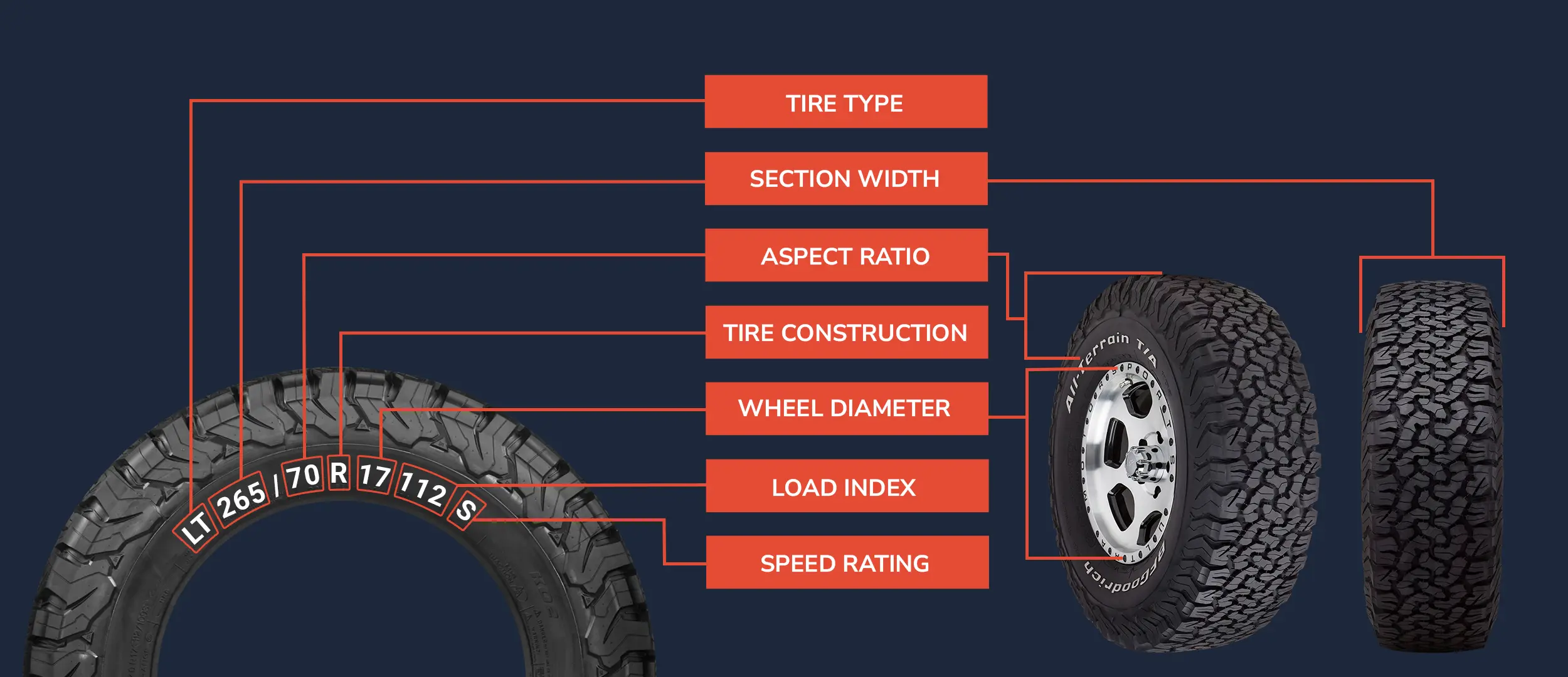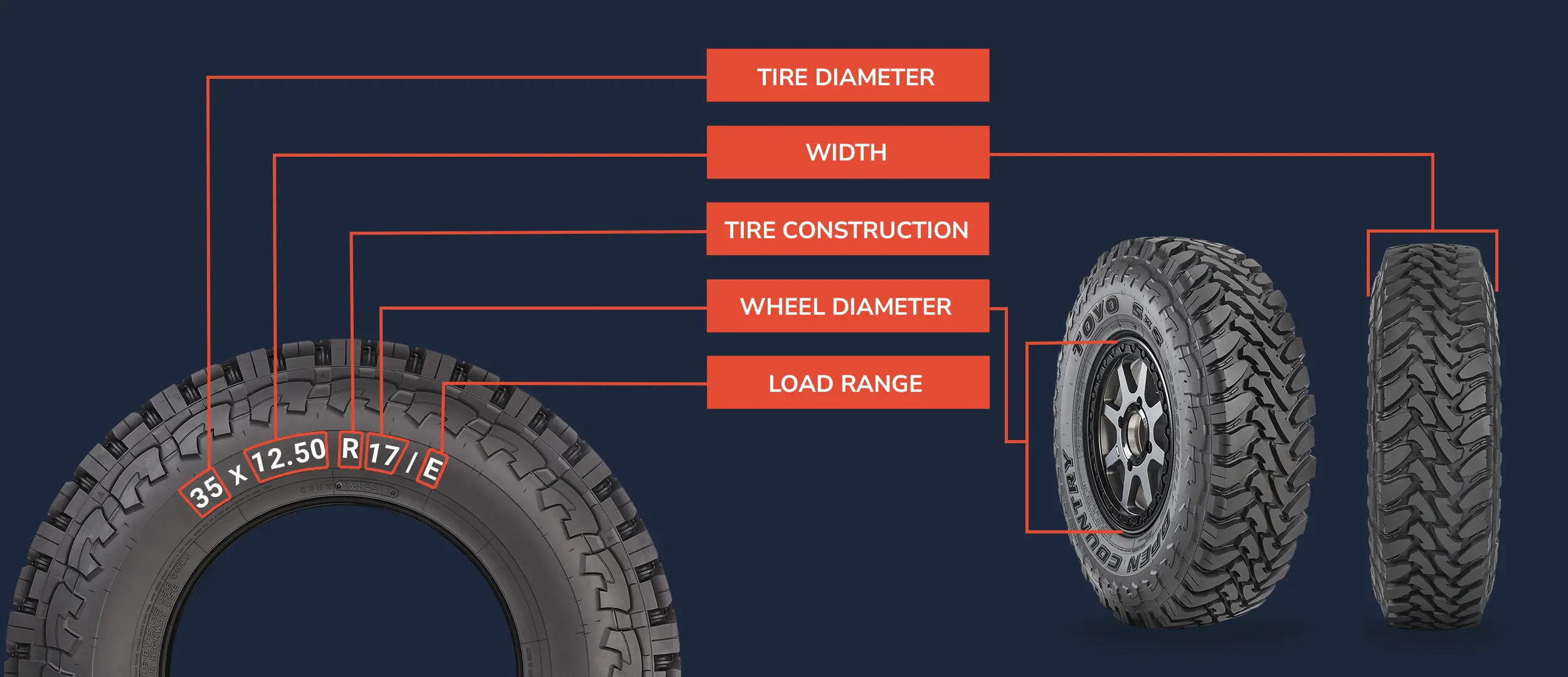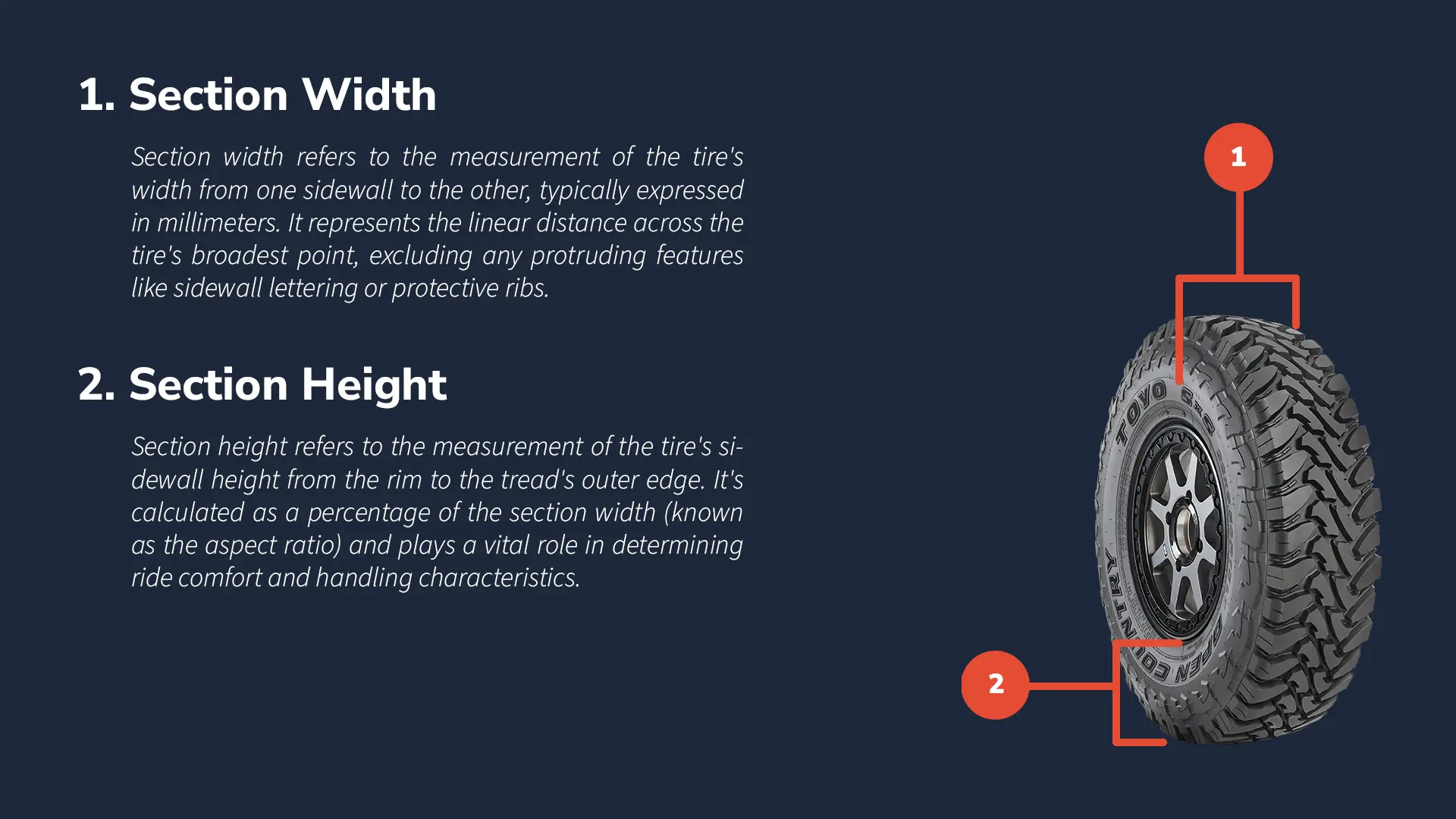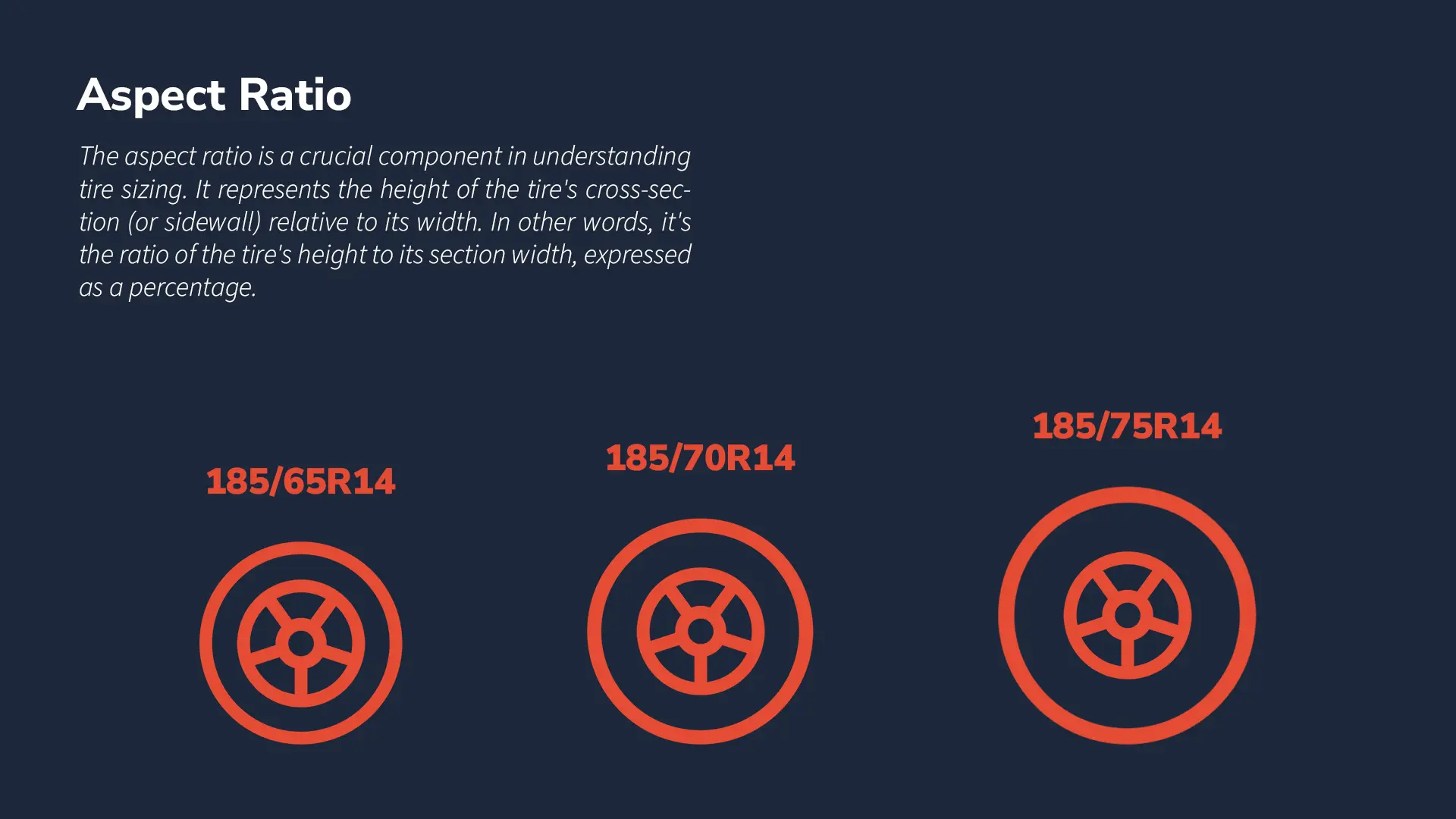Tire Compendium
Welcome to the Tire Compendium, an exclusive resource for industry professionals like you—tire shop employees and experts. From tire basics to types, specifications, and fitment guidance, this comprehensive guide will elevate your expertise. Decode sidewall codes and offer tailored recommendations, optimizing vehicle performance and safety. Let's raise the bar together in the tire industry!
Tire Size
Understanding tire size is a critical aspect of your role as a wheel and tire shop professional. The numbers on the sidewall may seem complex, encompassing both millimeters and inches, but it's really quite simple once you understand the basics. Furthermore, the correct size for a customer's car, truck, or trailer may vary based on driving conditions and individual preferences.
As a starting point for any tire-related service, it's essential for wheel and tire shop professionals to accurately understand the Original Equipment (OE) fitment for a customer's vehicle. This information can typically be found in the owner's manual or on the door placard, usually situated on the driver's side door jam. This size signifies the manufacturer's intended specifications for the vehicle and serves as a foundational reference for understanding the OE tire characteristics.
However, it's also vital to recognize that many factors may necessitate changes to the original tire size. These factors can include the installation of aftermarket wheels, modifications to the vehicle's suspension, and specific use cases outlined by the customer. Navigating these considerations with expertise ensures that you can provide tailored solutions that align with both the vehicle's design and the customer's unique needs.
How to read tire sizes
Tire sizes are more than just a series of numbers and letters printed on a tire's sidewall. They are crucial codes that reveal essential information about a tire's dimensions, type, and performance characteristics. For professionals working in wheel and tire shops, the ability to accurately read and interpret these codes is fundamental to providing customers with the right products and services. Understanding tire sizes ensures proper fitment, alignment, and optimal vehicle performance, and it helps in maintaining safety standards.
When it comes to tire sizing, there are several types, but the two most common are known as Metric and Flotation.
Metric Sizing
This is the standard used by most passenger vehicles around the world. It includes details such as the tire's width, aspect ratio, construction, and diameter, among other specifications. A typical example of a Metric size would be 225/55R17.

Flotation Sizing
Flotation sizes are typically used for trucks and off-road vehicles. These sizes are often displayed differently from Metric sizes and include information relevant to the tire's application on heavier or specialized vehicles. An example might be 31x10.50R15LT.

Tire Types
The tire type, often indicated by a letter or letters at the beginning of the tire size description, plays a crucial role in identifying the specific application or vehicle classification for which a tire is designed. Recognizing and understanding these types is essential for professionals in wheel and tire shops as it ensures the appropriate selection and installation of tires, aligned with the vehicle's purpose and the customer's needs.
Passenger (P)
P-metric tires are designed for passenger vehicles, including cars, minivans, SUVs, and light-duty pickup trucks. Selecting a P-type tire means adhering to standard measurements and specifications for typical passenger vehicles. It ensures comfort, performance, and safety in everyday driving conditions.
Light Truck (LT)
LT tires are constructed for light to medium trucks, larger SUVs, and vans. They are built to handle heavier loads and more rugged conditions compared to P-type tires. Knowing when to choose an LT tire is vital for vehicles that require enhanced durability and can handle heavy-duty applications, such as towing or off-road driving.
Special Trailer (ST)
ST tires are specifically designed for trailers, including boat trailers, utility trailers, and campers. Utilizing ST tires ensures that the unique needs of trailers, such as load distribution and stability, are met. Incorrect tire types can lead to poor handling and reduced safety.
Temporary (T)
T-type or temporary tires are commonly known as spare or "donut" tires. They are intended for short-term use to replace a flat or damaged tire. Recognizing a T-type tire ensures that it is used appropriately as a temporary solution, not for prolonged driving, as it may not provide the same performance or safety features as a standard tire.
Section Width
The section width of a tire refers to the measurement of the tire's width from one sidewall to the other. It's one of the most fundamental aspects of a tire's size and plays a significant role in how a tire fits and performs on a vehicle.

The section width is typically measured in millimeters and is part of the standardized code found on a tire's sidewall. For instance, in the tire size 225/55R17, the section width is 225 millimeters. This measurement doesn't include any protruding features like sidewall lettering or protective ribs, focusing solely on the core width of the tire.
Aspect Ratio
The aspect ratio is a crucial component in understanding tire sizing. It represents the height of the tire's cross-section (or sidewall) relative to its width. In other words, it's the ratio of the tire's height to its section width, expressed as a percentage. The aspect ratio is typically found in the tire size description on the sidewall.

For example, in the tire size 225/55R17, the aspect ratio is 55, meaning the height of the tire's sidewall is 55% of its section width. In this example the sidewall height would be 123.75 MM (~4.8 inches). This can be useful in many cases, especially when changing the diameter of the wheel and trying to maintain the same outside diameter of the tire. You will need to adjust the aspect ratio to compensate for the larger wheel diameter.
Tire Construction
Tire construction refers to the arrangement and material of the internal structure of a tire. It directly impacts the tire's overall performance, durability, and suitability for various applications. Among the different construction types, radial (R) and diagonal (bias) (D) constructions are the most common, each offering distinct characteristics and benefits.
Radial Construction (R)
Radial construction is characterized by the radial alignment of internal cords or plies. In this design, the fibers run perpendicularly to the tire's direction of travel, or radially from the center of the tire. This leads to improved ride comfort due to more flexible sidewalls and enhanced tread life through more uniform wear. Reduced rolling resistance in radial tires can also contribute to fuel economy. Radial tires have become the standard for most passenger vehicles, light trucks, and commercial vehicles because of their numerous advantages in comfort and efficiency.
Diagonal (Bias) Construction (D)
Diagonal (Bias) construction, on the other hand, features internal plies that are laid diagonally to the tire's direction of travel, with the plies overlapping in a crisscross pattern. This construction type offers greater load capacity, making it capable of handling heavier loads, and is known for its toughness and durability, particularly on rough or off-road surfaces. However, diagonal tires may not provide as smooth a ride as radial tires and are generally less fuel-efficient. They are often used in specific applications like agricultural equipment, off-road vehicles, and certain trailers where their strength is advantageous.
Run-Flat Tires (F)
The designation "F" in modern tire construction typically refers to run-flat tires. These tires are designed to maintain their shape and continue to perform even when they have lost all air pressure. The ability to run flat for a certain distance at a reduced speed provides added safety and convenience in the event of a puncture or blowout, allowing drivers to reach a safe location or service center for repair or replacement. Understanding and recognizing the "F" designation is essential for professionals, as run-flat tires require specific handling, installation, and compatibility considerations.
Inside Diameter
The inside diameter, commonly referred to as the wheel diameter, refers to the distance across the inside of the tire in inches or millimeters, depending on the region and standard. This measurement corresponds directly to the diameter of the wheel on which the tire is mounted.
Wheel diameters vary widely across different types of vehicles, from small passenger cars to heavy-duty trucks. Common wheel diameters include, but are not limited to:
- 13 to 16 inches: Typically found in compact and some mid-size cars.
- 17 to 20 inches: Common in larger cars, SUVs, and light trucks.
- 21 inches and above: Often used in luxury vehicles, performance cars, and specialized applications.
Load Index
When it comes to selecting the right tire for a vehicle, one critical factor that must be taken into consideration is the Load Index. This guide aims to equip you, the tire professional, with a comprehensive understanding of what the load index means, why it's important, and how to apply this knowledge in various scenarios, including dually applications.
The load index is a numerical value that corresponds to the maximum weight a tire can carry when inflated properly. This figure is not just a recommendation; it's a safety standard that must be met or exceeded. Selecting a tire with an inappropriate load index can lead to tire failure and safety hazards.
In some commercial and heavy-duty applications, such as dually wheels (where two tires are paired on each side), a tire may display two load indexes. The first number refers to the load capacity when used in a single configuration, while the second number refers to the load capacity when used in a dual configuration.
| Code | Weight (Lbs) | Weight (KG) |
|---|---|---|
| 65 | 639 | 290 |
| 66 | 661 | 300 |
| 67 | 677 | 307 |
| 68 | 694 | 315 |
| 69 | 717 | 325 |
| 70 | 739 | 335 |
| 71 | 761 | 345 |
| 72 | 783 | 355 |
| 73 | 805 | 365 |
| 74 | 827 | 375 |
| 75 | 853 | 387 |
| 76 | 882 | 400 |
| 77 | 908 | 412 |
| 78 | 937 | 425 |
| 79 | 963 | 437 |
| 80 | 992 | 450 |
| 81 | 1019 | 462 |
| 82 | 1047 | 475 |
| 83 | 1074 | 487 |
| 84 | 1102 | 500 |
| 85 | 1135 | 515 |
| 86 | 1168 | 530 |
| 87 | 1202 | 545 |
| 88 | 1235 | 560 |
| 89 | 1279 | 580 |
| 90 | 1323 | 600 |
| 91 | 1356 | 615 |
| 92 | 1389 | 630 |
| 93 | 1433 | 650 |
| 94 | 1477 | 670 |
| 95 | 1521 | 690 |
| 96 | 1565 | 710 |
| 97 | 1609 | 730 |
| 98 | 1653 | 750 |
| 99 | 1709 | 775 |
| 100 | 1764 | 800 |
| 101 | 1819 | 825 |
| 102 | 1874 | 850 |
| 103 | 1929 | 875 |
| 104 | 1984 | 900 |
| 105 | 2039 | 925 |
| 106 | 2094 | 950 |
| 107 | 2150 | 975 |
| 108 | 2205 | 1000 |
| 109 | 2271 | 1030 |
| 110 | 2337 | 1060 |
| 111 | 2403 | 1090 |
| 112 | 2469 | 1120 |
| Code | Weight (Lbs) | Weight (KG) |
|---|---|---|
| 113 | 2535 | 1150 |
| 114 | 2601 | 1180 |
| 115 | 2679 | 1215 |
| 116 | 2756 | 1250 |
| 117 | 2833 | 1285 |
| 118 | 2910 | 1320 |
| 119 | 2998 | 1360 |
| 120 | 3086 | 1400 |
| 121 | 3197 | 1450 |
| 122 | 3307 | 1500 |
| 123 | 3417 | 1550 |
| 124 | 3527 | 1600 |
| 125 | 3638 | 1650 |
| 126 | 3748 | 1700 |
| 127 | 3858 | 1750 |
| 128 | 3968 | 1800 |
| 129 | 4079 | 1850 |
| 130 | 4189 | 1900 |
| 131 | 4299 | 1950 |
| 132 | 4409 | 2000 |
| 133 | 4542 | 2060 |
| 134 | 4674 | 2120 |
| 135 | 4806 | 2180 |
| 136 | 4938 | 2240 |
| 137 | 5071 | 2300 |
| 138 | 5203 | 2360 |
| 139 | 5357 | 2430 |
| 140 | 5512 | 2500 |
| 141 | 5677 | 2575 |
| 142 | 5842 | 2650 |
| 143 | 6008 | 2725 |
| 144 | 6173 | 2800 |
| 145 | 6393 | 2900 |
| 146 | 6614 | 3000 |
| 147 | 6779 | 3075 |
| 148 | 6945 | 3150 |
| 149 | 7165 | 3250 |
| 150 | 7385 | 3350 |
| 151 | 7606 | 3450 |
| 152 | 7826 | 3550 |
| 153 | 8047 | 3650 |
| 154 | 8267 | 3750 |
| 155 | 8543 | 3875 |
| 156 | 8818 | 4000 |
| 157 | 9094 | 4125 |
| 158 | 9370 | 4250 |
| 159 | 9645 | 4375 |
| 160 | 9921 | 4500 |
Load Range
Load Range designates the tire's maximum load-carrying capacity at a specified inflation pressure, serving as a modern equivalent to the older ply rating system. Unlike the Load Index, which numerically specifies the exact weight a tire can support, Load Range indicates a category of strength based on the tire's construction and its ability to handle pressure. This specification is crucial, especially for vehicles that encounter heavy-duty use, including light trucks, RVs, and trailers, ensuring that the tires can withstand the rigors of their intended applications without compromising safety or performance.
Understanding both Load Range and Load Index is essential for recommending the appropriate tires for a vehicle. While the Load Index provides a precise maximum weight capacity, the Load Range offers additional insight into the tire's durability and suitability for heavy loads or high-pressure scenarios. Together, they guide professionals in selecting tires that not only support the vehicle's weight but also match its operational demands, ensuring optimal safety and efficiency across varying conditions.
| Code | Ply Rating | Max Pressure (psi) |
|---|---|---|
| A | 2 | - |
| B | 4 | 35 |
| C | 6 | 50 |
| D | 8 | 65 |
| E | 10 | 80 |
| F | 12 | 95 |
| Code | Ply Rating | Max Pressure |
|---|---|---|
| G | 14 | 110 |
| H | 16 | 120 |
| J | 18 | ~120+ |
| L | 20 | 120+ |
| M | - | - |
| N | - | - |
Beyond the traditional Load Range designations, additional codes like LL (Light Load), SL (Standard Load), XL (Extra Load), and HL (Heavy Load) offer further specificity for passenger tire load capacities. LL indicates tires designed for lighter carrying capacities, suitable for certain compact cars where fuel efficiency is optimized with lower load demands. SL, the most common designation, represents the standard load capacity for many passenger vehicles, providing a balanced performance for everyday driving conditions. XL, as mentioned, caters to vehicles that require a higher load capacity, often due to heavier vehicle weights or the need for carrying additional passengers or cargo. HL, the newest category among these, signifies tires designed to support even heavier loads than XL tires, addressing the increasing load requirements of modern SUVs, crossovers, and electric vehicles which typically weigh more due to their battery systems. These codes, while distinct from traditional Load Ranges, serve a similar purpose: they guide professionals and consumers in selecting tires that align with their vehicle’s specific weight and performance needs, ensuring safety, durability, and optimal driving performance.
Speed Rating
The speed rating is a standardized system that classifies a tire's capability to handle sustained speeds without exceeding its design limitations. It is denoted by a letter code, each representing a specific maximum speed. The speed rating ensures that the tire's performance, safety, and durability align with the vehicle's top speed. The speed rating is usually found at the end of the tire's size designation, right after the load index. For example, in the code 225/45R17 94W, the letter "W" denotes the speed rating.
In addition to the standard speed ratings, there are special designations that professionals must be aware of when dealing with specific applications or unique vehicle requirements. For instance, some high-performance tires may carry a "Y" rating, indicating a maximum speed of up to 186 mph (300 km/h), while an additional "ZR" rating can signify capabilities beyond certain thresholds. Another example is the "C" rating, commonly found in commercial vehicle tires, which often relates to the tire's capacity for carrying loads at certain speeds. Understanding these unique designations and their implications is essential in the professional selection and fitting of tires, as they directly impact the performance, safety, and compliance of the tire with specific vehicle needs.
| Code | Speed Rating (MPH) | Speed Rating (KPH) |
|---|---|---|
| A1 | 3 | 5 |
| A2 | 6 | 10 |
| A3 | 9 | 15 |
| A4 | 12 | 20 |
| A5 | 16 | 25 |
| A6 | 19 | 30 |
| A7 | 22 | 35 |
| A8 | 25 | 40 |
| B | 31 | 50 |
| C | 37 | 60 |
| D | 40 | 65 |
| E | 43 | 70 |
| F | 50 | 80 |
| G | 56 | 90 |
| J | 62 | 100 |
| K | 68 | 110 |
| Code | Speed Rating (MPH) | Speed Rating (KPH) |
|---|---|---|
| L | 75 | 120 |
| M | 81 | 130 |
| N | 87 | 140 |
| P | 94 | 150 |
| Q | 100 | 160 |
| R | 106 | 170 |
| S | 112 | 180 |
| T | 118 | 190 |
| U | 124 | 200 |
| H | 130 | 210 |
| V | 149 | 240 |
| Z | 149 | 240 |
| W | 168 | 270 |
| (W) | 168 | 270 |
| Y | 186 | 300 |
| (Y) | 186 | 300 |
What's Next?
Having explored the vital sizes and specifications for tires, including load range, speed ratings, and the implications of OE specifications, you're now equipped with the foundational knowledge needed for making informed tire choices. The next critical step is understanding how these elements come together to influence the selection of the correct tire size for your vehicle. To navigate this process with confidence, we invite you to utilize our comprehensive Tire Selection Guide. This resource is designed to help you apply what you've learned, ensuring you choose tires that not only fit your vehicle perfectly but also align with your driving needs and safety requirements.
Still have questions?
Don't hesitate to reach out to our amazing sales staff. We are more than happy to work with you to understand your specific needs and recommend the product(s) that will work best for your unique situation.
